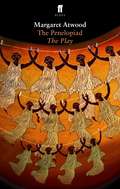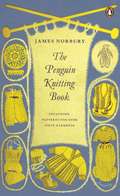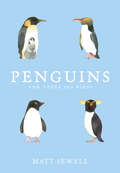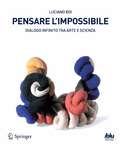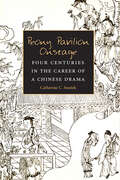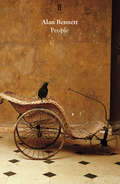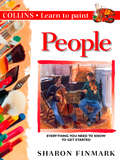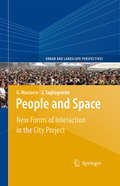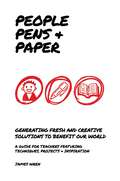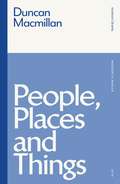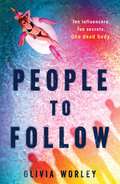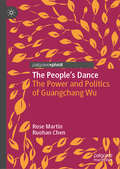- Table View
- List View
The Penelopiad: The Myth Of Penelope And Odysseus (Canons Ser. #80)
by Margaret AtwoodAs portrayed in Homer's Odyssey, Penelope - wife of Odysseus and cousin of the beautiful Helen of Troy - has become a symbol of wifely duty and devotion, enduring twenty years of waiting when her husband goes to fight in the Trojan War. As she fends off the attentions of a hundred greedy suitors, travelling minstrels regale her with news of Odysseus' epic adventures around the Mediterranean - slaying monsters and grappling with amorous goddesses. When Odysseus finally comes home, he kills her suitors and then, in an act that served as little more than a footnote in Homer's original story, inexplicably hangs Penelope's twelve maids.Now, Penelope and her chorus of wronged maids tell their side of the story in a new stage version by Margaret Atwood, adapted from her own wry, witty and wise novel.The Penelopiad premiered with the Royal Shakespeare Company in association with Canada's National Arts Centre at the Swan Theatre, Stratford-upon-Avon, in July 2007.
The Penguin Knitting Book
by James NorburyThe Penguin Knitting Book by James Norbury is a charming how-to-knit classic packed with delightfully vintage advice.Knitting fills a fascinating page in the human story. I know of no home-craft that enjoys the universal popularity of hand-knittingJames Norbury's The Penguin Knitting Book, first published in 1957, is a how-to guide for the experienced knitter as well as the beginner. Full of wit and charm as well as tips and techniques for the contemporary knitter, The Penguin Knitting Book entertainingly illustrates all things vintage in the world of wool.Along with telling you how to knit, The Penguin Knitting Book includes original vintage patterns for every member of the family. Babies' coats, pullovers for father, sweaters for the teenager, dresses, jumpers, coats and cardigans, you will find them all in this charming aid to better knitting.'James Norbury was the strongest single influence in British knitting during the twenty-five years after the Second World War' Sir Bishop Richard Rutt, author of A History of Hand Knitting'[In the late 1960s] there was a chap called James Norbury, who had his own knitting show on the BBC. I sat in on some of the programmes, and good stuff it was, too. I learned lots of racy stuff about 'knit one, purl one'' Sir David Attenborough'Knitting is the saving of a life' Virginia WoolfJames Norbury wrote The Penguin Knitting Book in 1957. He travelled extensively throughout the world, studying every aspect of the knitter's craft. A knitting historian, teacher and designer as well as a television star on his own BBC knitting show, he was Chief Designer for Patons and one of the foremost authorities on the history of knitting.
Penguins and Other Sea Birds
by Matt SewellDid you know... The Galápagos Penguin's speckled markings make each of them as unique as a snowflake? The Emperor Penguin weighs the same as a Labrador retriever? The Adélie Penguin takes its name from the sweetheart of a Napoleonic naval captain turned explorer? From tiny fairy penguins to the regal emperor penguin, street artist and ornithologist, Matt Sewell, illustrates one of the world’s favourite birds in this charming follow-up to Owls, Our Garden Birds, Our Songbirds and Our Woodland Birds. Matt captures the famously quirky characters of penguins through his unique and much-loved watercolours accompanied by whimsical descriptions. You'll discover everything you've ever wondered about this enigmatic bird and his feathered friends from across the globe.
Penny the Panda Knitting Pattern: A quick & easy knitting project (Knitted Toy Travels)
by Laura LongGot a taste for travel? Taken from Laura Long's fantastic book, Knitted Toy Travel, this unique quick & easy project teaches you how to knit your very own Penny the Panda. Have heaps of fun whilst expanding your crafting skills at the same time!This unique project includes:Simple step-by-step instructionsQuick makes for fast resultsBeautiful photography of the finished product to guide and inspire
Pensare l'impossibile: Dialogo infinito tra arte e scienza (I blu)
by Luciano BoiIn questo libro matematica e arte si incontrano, confrontando ed esplorando tre oggetti-concetti: nodi, buchi e spazi. Oggetti fisici e concetti astratti allo stesso tempo, i nodi e i buchi sono strumenti di creazione e generatori di forme: si intrecciano e si compenetrano su più piani, ridefinendo le configurazioni e le dinamiche dello spazio.Anche se generalmente non ne siamo consapevoli, nodi e buchi sono onnipresenti, pervadono la nostra vita quotidiana e noi stessi. Queste forme danno luogo a una rigenerazione continua della realtà e partecipano al senso del vero e del bello che avvertiamo nella ricerca incessante per capire il mondo che ci circonda. Nodi e buchi costituiscono elementi fondamentali dei molteplici spazi studiati dai matematici e dai fisici teorici. Eppure non è facile, neanche per un matematico, “pensare” un nodo, un buco, gli spazi a n-dimensioni o l’infinito.Accanto a riflessioni matematiche, filosofiche e letterarie, il libro propone e indaga opere d’arte di diverse epoche. In particolare, due grandi artisti – Jorge Eielson e Lucio Fontana – sono riusciti nell’intento di “pensare l’impossibile”, di rendere visibile l’invisibile, di immaginare l’infinito al di là delle immagini finite e apparenti.Il nodo esprime dunque un percorso interiore, dove analisi e intuizione si incontrano e si fondono in un atto di creazione, ma rappresenta anche un percorso concreto che si svolge nello spazio e nel tempo e lungo il quale culture, saperi e persone si legano per costruire un dialogo infinito.Questo libro è un invito a entrare nel mondo meraviglioso dei nodi e dei buchi, sorgenti di conoscenza, principi di vita, fonti di desiderio, ragioni di eresia.
The Pensive Image: Art as a Form of Thinking
by Hanneke GrootenboerWhile the philosophical dimension of painting has long been discussed, a clear case for painting as a form of visual thinking has yet to be made. Traditionally, vanitas still life paintings are considered to raise ontological issues while landscapes direct the mind towards introspection. Grootenboer moves beyond these considerations to focus on what remains unspoken in painting, the implicit and inexpressible that manifests in a quality she calls pensiveness. Different from self-aware or actively desiring images, pensive images are speculative, pointing beyond interpretation. An alternative pictorial category, pensive images stir us away from interpretation and toward a state of suspension where thinking through and with the image can start. In fluid prose, Grootenboer explores various modalities of visual thinking— as the location where thought should be found, as a refuge enabling reflection, and as an encounter that provokes thought. Through these considerations, she demonstrates that art works serve as models for thought as much as they act as instruments through which thinking can take place. Starting from the premise that painting is itself a type of thinking, The Pensive Image argues that art is capable of forming thoughts and shaping concepts in visual terms.
The Pensive Image: Art as a Form of Thinking
by Hanneke GrootenboerWhile the philosophical dimension of painting has long been discussed, a clear case for painting as a form of visual thinking has yet to be made. Traditionally, vanitas still life paintings are considered to raise ontological issues while landscapes direct the mind towards introspection. Grootenboer moves beyond these considerations to focus on what remains unspoken in painting, the implicit and inexpressible that manifests in a quality she calls pensiveness. Different from self-aware or actively desiring images, pensive images are speculative, pointing beyond interpretation. An alternative pictorial category, pensive images stir us away from interpretation and toward a state of suspension where thinking through and with the image can start. In fluid prose, Grootenboer explores various modalities of visual thinking— as the location where thought should be found, as a refuge enabling reflection, and as an encounter that provokes thought. Through these considerations, she demonstrates that art works serve as models for thought as much as they act as instruments through which thinking can take place. Starting from the premise that painting is itself a type of thinking, The Pensive Image argues that art is capable of forming thoughts and shaping concepts in visual terms.
The Pensive Image: Art as a Form of Thinking
by Hanneke GrootenboerGrootenboer considers painting as a form of thinking in itself, rather than a subject of philosophical and interpretive thought. While the philosophical dimension of painting has long been discussed, a clear case for painting as a form of visual thinking has yet to be made. Traditionally, vanitas still life paintings are considered to raise ontological issues while landscapes direct the mind toward introspection. Grootenboer moves beyond these considerations to focus on what remains unspoken in painting, the implicit and inexpressible that manifests in a quality she calls pensiveness. Different from self-aware or actively desiring images, pensive images are speculative, pointing beyond interpretation. An alternative pictorial category, pensive images stir us away from interpretation and toward a state of suspension where thinking through and with the image can start. In fluid prose, Grootenboer explores various modalities of visual thinking— as the location where thought should be found, as a refuge enabling reflection, and as an encounter that provokes thought. Through these considerations, she demonstrates that artworks serve as models for thought as much as they act as instruments through which thinking can take place. Starting from the premise that painting is itself a type of thinking, The Pensive Image argues that art is capable of forming thoughts and shaping concepts in visual terms.
Peony Pavilion Onstage: Four Centuries in the Career of a Chinese Drama (Michigan Monographs In Chinese Studies #88)
by Catherine SwatekAfter its completion in 1598, The Peony Pavilion (Mudan ting) began a four-hundred-year course of transmission and dissemination in China and around the world. Within China, the play’s wide popularity propelled its appearance in numerous editions, adaptations, and libretti. Performances ranged from “pure singing” at private gatherings to full stagings in commercial theaters. As the crown jewel of Kun opera reportoire, Mudan ting has a richly documented history and lends itself to careful study. In the late twentieth century, however, classical Kun opera is on the verge of extinction in China, and creative talent is gravitating to centers outside China’s mainland. In 1998, the play was reintroduced to audiences in Europe and North America in various versions, adding new chapters to the story of the work. Peony Pavilion Onstage examines Tang Xianzu’s classic play from three distinct viewpoints: public-literati playwrights; professional performers of Kun opera; and quite recently, directors and audiences outside China. Catherine Swatek first examines two adaptations of the play by Tang's contemporaries, which point to the unconventionality of the original work. She goes on to explore how the play has been changed in later adaptations, up to its most recent productions by Peter Sellars and Chen Shi-Zheng in the United States and Europe. Peony Pavilion Onstage is essential reading for scholars and performers of this masterpiece and other great works of Chinese drama.
People: A Centenary Of Service 1919-2019
by Alan BennettA sale? Why not? Release all your wonderful treasures onto the open market and they are there for everyone to enjoy. It's a kind of emancipation, a setting them free to range the world ... a saleroom here, an exhibition there; art, Lady Stacpoole, is a rover.People spoil things; there are so many of them and the last thing one wants is them traipsing through one's house. But with the park a jungle and a bath on the billiard table, what is one to do? Dorothy wonders if an attic sale could be a solution. People premieres at the National Theatre, London, in October 2012.As with Alan Bennett's previous two plays, The History Boys and The Habit of Art, People will open in the Lyttelton Theatre in a production directed by the National's artistic director Nicholas Hytner.- How're you doing?- Not sure.- Well why don't you get on the mobile to your dick and find out.
People (Collins Learn to Paint)
by Sharon FinmarkLearn to Paint People is a new ebook title in HarperCollins’ successful Learn to Paint series.
People and Buildings
by Robert GutmanThere is at the present time a continuing interest in relating the behavioral sciences to design disciplines. Sociologists and social psychologists have been added to faculties of architecture schools, where they off er seminars and participate as programming specialists and design critics in studio courses. Behavioral scientists in many European countries have collaborated with architects and planners in design work undertaken by governmental ministries, and more recently have been participating in the work of private design fi rms. Similar developments are now common in the United States.In this fascinating study of the "ecology of buildings," biologists, anthropologists, sociologists, psychologists, and architects analyze the effect of working and living spaces on human behavior. Focusing on such contemporary social problems as the influence of the physical environment on psychological stress, mental illness, family disorganization, urban violence, and delinquency, the contributors show that we must respect the constraints that the environment and the nature of man impose on human adaptability.The selections in People and Buildings have been written primarily by scientists and designers working in the behavioral mode. The selections within each part have been arranged to provide an ordered argument or exploration of the general topic with which the part as a whole deals. To facilitate the reader's appreciation of the argument, each selection is preceded by a short prefatory statement. In view of the fact that a single article or preface can hardly be representative of the depth of the literature that has developed around an argument, Gutman has included an annotated bibliography, which is keyed to the selections through the use of subheadings. A new introduction by Nathan Glazer has been prepared for this edition.
People and Buildings
by Robert GutmanThere is at the present time a continuing interest in relating the behavioral sciences to design disciplines. Sociologists and social psychologists have been added to faculties of architecture schools, where they off er seminars and participate as programming specialists and design critics in studio courses. Behavioral scientists in many European countries have collaborated with architects and planners in design work undertaken by governmental ministries, and more recently have been participating in the work of private design fi rms. Similar developments are now common in the United States.In this fascinating study of the "ecology of buildings," biologists, anthropologists, sociologists, psychologists, and architects analyze the effect of working and living spaces on human behavior. Focusing on such contemporary social problems as the influence of the physical environment on psychological stress, mental illness, family disorganization, urban violence, and delinquency, the contributors show that we must respect the constraints that the environment and the nature of man impose on human adaptability.The selections in People and Buildings have been written primarily by scientists and designers working in the behavioral mode. The selections within each part have been arranged to provide an ordered argument or exploration of the general topic with which the part as a whole deals. To facilitate the reader's appreciation of the argument, each selection is preceded by a short prefatory statement. In view of the fact that a single article or preface can hardly be representative of the depth of the literature that has developed around an argument, Gutman has included an annotated bibliography, which is keyed to the selections through the use of subheadings. A new introduction by Nathan Glazer has been prepared for this edition.
People and Space: New Forms of Interaction in the City Project (Urban and Landscape Perspectives #5)
by Giovanni Maciocco Silvano TagliagambeThis book explores new forms and modalities of relations between people and space that increasingly affect the life of the city. The investigation takes as its starting point the idea that in contemporary societies the loss of our relationship with place is a symptom of a breakdown in the relationship between ethics and aesthetics. This in turn has caused a crisis not only in taste, but also in our sense of beauty, our aesthetic instinct, and our moral values. It has also led to the loss of our engagement with the landscape, which is essential for cities to function. The authors argue that new, fertile forms of interaction between people and space are now happening in what they call the ‘intermediate space’, at the border of “urban normality” and those parts of a city where citizens experiment with unconventional social practices. This new interaction engenders a collective conscience, giving a new and productive vigor to the actions of individuals and also their relations with their environment. These new relations emerge only after we abandon what is called the “therapeutic illusion of space”, which still exists today, and which binds in a deterministic manner the quality of civitas, the associative life of people in the city, to the quality of urban space. Projects for the city should, instead, have as their keystone the notion of social action as a return to a critical perspective, to a courageous acceptance of social responsibility, at the same time as seeking the generative structures of urban life in which civitas and urbs again acknowledge each other.
People Flow in Buildings
by Marja-Liisa SiikonenDiscover how to measure, control, model, and plan people flow within modern buildings with this one-stop resource from a leading professional People Flow in Buildings delivers a comprehensive and insightful description of people flow, analysis with software-based tools. The book offers readers an up-to-date overview of mathematical optimization methods used in control systems and transportation planning methods used to manage vertical and horizontal transportation. The text offers a starting point for selecting the optimal transportation equipment for new buildings and those being modernized. It provides insight into making passenger journeys pleasant and smooth, while providing readers with an examination of how modern trends in building usage, like increasingly tall buildings and COVID-19, effect people flow planning in buildings. People Flow in Buildings clearly defines the terms and symbols it includes and then moves on to deal with the measurement, control, modelling, and planning of people flow within buildings of all kinds. Each chapter contains an introduction describing its contents and the background of the subject. Included appendices describe measured passenger data and performed analyses. Readers will also benefit from the inclusion of: A thorough introduction to people-counting methods, including counting technology inside and outside buildings, passenger traffic components, and manual people-counting An examination of the passenger arrival process in building, including the Poisson arrival process and probability density function, and passenger arrivals in batches A consideration of daily vertical passenger traffic profiles, including two-way traffic profiles and the effects of inter-floor traffic An exploration of people flow solutions, including stairs, escalators, and elevators with collective and destination group control systems, as well as double-deck and multicar system People flow calculation and simulation models Elevator planning with ISO simulation method Elevator planning and evacuation of tall buildings Perfect for software designers in the private sector and academia, People Flow in Buildings will also earn a place in the libraries of elevator consultants, manufacturers, and architects who seek a one-stop reference for transportation devices from a functional and design perspective, as opposed to a hardware perspective.
People Flow in Buildings
by Marja-Liisa SiikonenDiscover how to measure, control, model, and plan people flow within modern buildings with this one-stop resource from a leading professional People Flow in Buildings delivers a comprehensive and insightful description of people flow, analysis with software-based tools. The book offers readers an up-to-date overview of mathematical optimization methods used in control systems and transportation planning methods used to manage vertical and horizontal transportation. The text offers a starting point for selecting the optimal transportation equipment for new buildings and those being modernized. It provides insight into making passenger journeys pleasant and smooth, while providing readers with an examination of how modern trends in building usage, like increasingly tall buildings and COVID-19, effect people flow planning in buildings. People Flow in Buildings clearly defines the terms and symbols it includes and then moves on to deal with the measurement, control, modelling, and planning of people flow within buildings of all kinds. Each chapter contains an introduction describing its contents and the background of the subject. Included appendices describe measured passenger data and performed analyses. Readers will also benefit from the inclusion of: A thorough introduction to people-counting methods, including counting technology inside and outside buildings, passenger traffic components, and manual people-counting An examination of the passenger arrival process in building, including the Poisson arrival process and probability density function, and passenger arrivals in batches A consideration of daily vertical passenger traffic profiles, including two-way traffic profiles and the effects of inter-floor traffic An exploration of people flow solutions, including stairs, escalators, and elevators with collective and destination group control systems, as well as double-deck and multicar system People flow calculation and simulation models Elevator planning with ISO simulation method Elevator planning and evacuation of tall buildings Perfect for software designers in the private sector and academia, People Flow in Buildings will also earn a place in the libraries of elevator consultants, manufacturers, and architects who seek a one-stop reference for transportation devices from a functional and design perspective, as opposed to a hardware perspective.
People in Watercolour (Collins 30-Minute Painting)
by Trevor WaughThis practical and inspirational guide, in a handy sketchbook format, is aimed at the practised beginner and shows how to achieve successful watercolour paintings of people in just 30 minutes – ideal for the busy amateur artist who doesn't have much time to paint.
A People Passing Rude: British Responses To Russian Culture
by Anthony CrossDescribed by the sixteenth-century English poet George Turbervile as "a people passing rude, to vices vile inclin’d", the Russians waited some three centuries before their subsequent cultural achievements—in music, art and particularly literature—achieved widespread recognition in Britain. The essays in this stimulating collection attest to the scope and variety of Russia’s influence on British culture. They move from the early nineteenth century—when Byron sent his hero Don Juan to meet Catherine the Great, and an English critic sought to come to terms with the challenge of Pushkin—to a series of Russian-themed exhibitions at venues including the Crystal Palace and Earls Court. The collection looks at British encounters with Russian music, the absorption with Dostoevskii and Chekhov, and finishes by shedding light on Britain’s engagement with Soviet film. Edited by Anthony Cross, one of the world’s foremost authorities on Anglo-Russian relations, A People Passing Rude is essential reading for anyone with an interest in British and Russian cultures and their complex relationship.
A People Passing Rude: British Responses to Russian Culture
by Anthony CrossDescribed by the sixteenth-century English poet George Turbervile as "a people passing rude, to vices vile inclin’d", the Russians waited some three centuries before their subsequent cultural achievements—in music, art and particularly literature—achieved widespread recognition in Britain. The essays in this stimulating collection attest to the scope and variety of Russia’s influence on British culture. They move from the early nineteenth century—when Byron sent his hero Don Juan to meet Catherine the Great, and an English critic sought to come to terms with the challenge of Pushkin—to a series of Russian-themed exhibitions at venues including the Crystal Palace and Earls Court. The collection looks at British encounters with Russian music, the absorption with Dostoevskii and Chekhov, and finishes by shedding light on Britain’s engagement with Soviet film. Edited by Anthony Cross, one of the world’s foremost authorities on Anglo-Russian relations, A People Passing Rude is essential reading for anyone with an interest in British and Russian cultures and their complex relationship.
People, Pens and Paper: Fresh Ideas for Schools to Teach the Creative Process
by James WrenPeople, Pens & Paper is about creative and fresh ideas. It's not a creative rule book, but a suggestive guide of techniques and projects to make the creative process more fluid and more enjoyable for students. Often, it's our setting and mindset that determines creative output, so in order to be truly effective we need to set the scene, and that also includes within ourselves. At this initial stage of the process all we need are paper, pens and people - we keep it organic and focus on generating solutions without any interference. With the projects featured, there's a focus on seeking out solutions for our planet rather than profit and commercialism. These ideas are recorded in a simple sketch book. This book can then help form a 'portfolio' of concepts for each student, so not only do the ideas look to help our world, they also show initiative and entrepreneurial flair, useful for life beyond school. From a marketing campaign for a local charity through to looking at ways to solve traffic issues at a school, teachers will be able to use innovative projects to inspire and also foster habitual ways to conceptualise, be it written or doodled.Readers will find no rules or quick-fixes.People, Pens & Paper is all about the process.
People, Personal Data and the Built Environment (Springer Series in Adaptive Environments)
by Holger Schnädelbach David KirkPersonal data is increasingly important in our lives. We use personal data to quantify our behaviour, through health apps or for 'personal branding' and we are also increasingly forced to part with our data to access services. With the proliferation of embedded sensors, the built environment is playing a key role in this developing use of data, even though this remains relatively hidden. Buildings are sites for the capture of personal data. This data is used to adapt buildings to people's behaviour, and increasingly, organisations use this data to understand how buildings are occupied and how communities develop within them. A whole host of technical, practical, social and ethical challenges emerge from this still developing area across interior, architectural and urban design, and many open questions remain.This book makes a contribution to this on-going discourse by bringing together a community of researchers interested in personal informatics and the design of interactive buildings and environments. The book’s aim is to foster critical discussion about the future role of personal data in interactions with the built environment.People, Personal Data and the Built Environment is ideal for researchers and practitioners interested in Architecture, Computer Science and Human Building Interaction.
People, Places and Things (Modern Classics)
by Duncan Macmillan"Macmillan doesn't shy away from difficult questions about addiction and recovery and, rightly, doesn't answer them ... this is a bold, timely and searching play" - Financial TimesEmma was having the time of her life. Now she's in rehab. Her first step is to admit that she has a problem. But the problem isn't with Emma, it's with everything else. She needs to tell the truth. But she's smart enough to know that there's no such thing. When intoxication feels like the only way to survive the modern world, how can she ever sober up?People, Places & Things premiered at the National Theatre in 2015 before transferring to London's West End and St. Ann's Warehouse in New York.Published for the first time in Methuen Drama's Modern Classics series, this edition features a brand new introduction by Naomi Obeng.
People, Places and Things (Modern Classics)
by Duncan Macmillan"Macmillan doesn't shy away from difficult questions about addiction and recovery and, rightly, doesn't answer them ... this is a bold, timely and searching play" - Financial TimesEmma was having the time of her life. Now she's in rehab. Her first step is to admit that she has a problem. But the problem isn't with Emma, it's with everything else. She needs to tell the truth. But she's smart enough to know that there's no such thing. When intoxication feels like the only way to survive the modern world, how can she ever sober up?People, Places & Things premiered at the National Theatre in 2015 before transferring to London's West End and St. Ann's Warehouse in New York.Published for the first time in Methuen Drama's Modern Classics series, this edition features a brand new introduction by Naomi Obeng.
People to Follow: A Gripping Social-Media Thriller
by Olivia WorleyTen influencers. Ten secrets. One dead body. A pacy, page-turning thriller perfect for fans of We Were Liars, The Inheritance Games and One Of Us Is Lying.'Agatha Christie meets TikTok . . . a wicked, juicy page-turner' - Alexa Donne, author of Brightly BurningThey're used to being followed. But not like this . . . Ten social media stars think they're about to join the cast of a hot new reality show. But the production crew never shows up, and the influencers find themselves stranded on a deserted Caribbean island with no contact with the outside world - except for messages from the mysterious 'Sponsor', who is threatening to expose their darkest secrets. When one of them winds up dead, things start to get more real than they bargained for . . .With the body count rising, the influencers must figure out who is trying to get them cancelled - like, literally - before their number one follower strikes again.
The People’s Dance: The Power and Politics of Guangchang Wu (Critical Studies in Dance Leadership and Inclusion)
by Rose Martin Ruohan ChenThis book presents an analysis of how the grassroots movement of Guangchang Wu or ‘square dance’ in China has become a national phenomenon. Through oral narratives offering rich descriptions of lived encounters, the experiences of those involved in leading, organizing, teaching and learning Guangchang Wu are revealed. Through these narratives, this book serves to understand the leadership practices occurring and how this dance practice is deeply rooted in the complexities of China’s rapid economic development, acceleration of urbanisation, and the desire for a healthier and more communal lifestyle.
